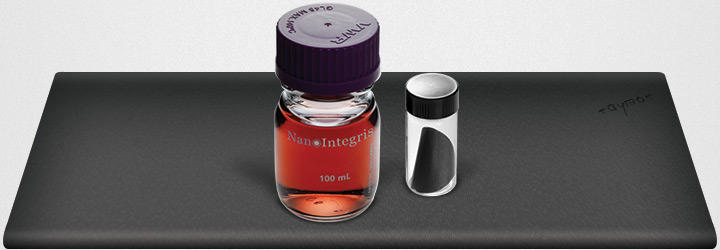
A semiconducting carbon nanotube ink with the highest purity ever measured coupled to a fully scalable manufacturing route: IsoSol-S100. The semiconducting single-wall carbon nanotubes are sourced from the highly-scalable RF-plasma grown carbon nanotubes, and separated using a conjugated polymer extraction process.
Product Summary
The use of specialized patent-pending dialkyl homopolymers developed by the National Research Council of Canada within the Printable Electronics Consortium, has enabled us to disperse and extract single-walled carbon nanotubes to the highest levels of semiconducting enrichment and purity to date: IsoSol-S100. The starting materials are the purified and highly-scalable RF-plasma grown carbon nanotubes supplied by Raymor Nanotech1.
UV-Vis-NIR spectrophotometric assessment of purity2 indicate that this material has semiconducting purities at or greater than 99.9% with the metrics of Itkis Ratio3 and Phi Values4 exceeding 0.5 and 0.4, respectively.
The highly graphitized starting material and low sonication intensity utilized for the extraction technique minimizes damage to the nanotubes, allowing the material to exhibit high crystallinity and longer average lengths of 1μm, not previously seen when utilizing DGU5 or Chromatography-based6 separation methods.
Additionally, the material is processed in organic solvent and the polymer/nanotube ratio can be adjusted to less than a factor of four with nanotube concentrations 10x higher than our aqueous dispersions. The solutions also display stabilities of greater than six months. These properties promote great nanotube deposition and adhesion for device
creation.
Experimentally, thin film transistors, prepared on SiO2/Si substrates7 have led to average mobilities exceeding 27cm2/(Vs) and On/Off ratios of 1.8×106 and is perfectly-suited for commercial ink jet and aerosol jet printing.
1K. S. Kim, A. Moradian, J. Mostaghimi, Y. Alinejad, A. Shahverdi, B. Simard and G. Soucy, Nano Research, 2009, 2, 800.
2M. Ouyang , J. Huang , and C.M. Lieber, Acc. Chem. Res. , 2002, 35 (12), 1018-1025.
3J. Chen, A.M. Rao, S. Lyuksyutov, M.E. Itkis, M.A. Hamon, H. Hu, R.W. Cohn, P.C. Eklund, D.T. Colbert, R.E. Smalley, and R.C. Haddon, J. Phys. Chem. B, 2001, 105 (13), 2525–2528.
4K.S. Mistry, B.A. Larsen, and J.L. Blackburn, ACS Nano, 2013, 7, 2231-2239.
5M.S. Arnold, A.A. Green, J.F. Hulvat, S.I. Stupp, and M.C. Hersam, Nat. Nanotechnol., 2008, 3, 387, 394.
6M. Zheng and E.D. Semke, J. Am. Chem. Soc., 2007, 129, 6084-6085.
7J. Ding, Z. Li, J. Lefebvre, F. Cheng, G. Dubey, S. Zou, P. Finnie, A. Hrdina, L. Scoles, G.P. Lopinski, C. T. Kingston, B. Simard, and P.R.L. Malenfant, Nanoscale, 2014, 6, 2328-2339.
Product Specifications
| Optical Purity | >99.9% |
| Itkis Ratio (Ї) | >0.5 |
| Phi Value (Φ) | >0.39 |
| Nanotube Concentration | >0.01mg/mL |
| Surfactant : Nanotube Concentration | <4 |
| Standard Solvent Media | Toluene |
| Shelf Life | 6-9 months |
SEM and AFM
![[cml_media_alt id='791']IsoSol-S100_SEM[/cml_media_alt]](/wp-content/uploads/2014/11/IsoSol-S100_SEM.jpg) Images used by permission of H. Chen: Nanotechnology Research Laboratory, Department of Electrical Engineering, University of Southern California.
Images used by permission of H. Chen: Nanotechnology Research Laboratory, Department of Electrical Engineering, University of Southern California.
![[cml_media_alt id='783']SEM and AFM[/cml_media_alt]](/wp-content/uploads/2014/11/090214_AFM_cnt_S23-081.jpg) Image used by permission of H. Chen: Nanotechnology Research Laboratory, Department of Electrical Engineering, University of Southern California.
Image used by permission of H. Chen: Nanotechnology Research Laboratory, Department of Electrical Engineering, University of Southern California.
| Diameter Range | 1.2 – 1.4 nm |
| Mean Length | 1 μm |
Raman
![[cml_media_alt id='780']IsoSol-S100 Raman[/cml_media_alt]](/wp-content/uploads/2014/11/140901_IsoSol-S100_Raman.png) Image used by permission of P. Malenfant: Security and Disruptive Technologies Portfolio, National Research Council Canada.
Image used by permission of P. Malenfant: Security and Disruptive Technologies Portfolio, National Research Council Canada.
The Radical Breath Mode (RBM) of the spectra excited at 785nm shows that the IsoSol-S100 material has a nearly flat baseline in the metallic region from 145 to 175 cm-1, indicative of a high semiconducting purity.
| Metal Catalyst Impurity | <0.5% |
| Amorphous Carbon Impurity |
PLE Map
![[cml_media_alt id='777']PLE Map[/cml_media_alt]](/wp-content/uploads/2014/11/PFDD74_purple.png) Image used by permission of P. Malenfant: Security and Disruptive Technologies Portfolio, National Research Council Canada.
Image used by permission of P. Malenfant: Security and Disruptive Technologies Portfolio, National Research Council Canada.
A photoluminescence excitation (PLE) map for the IsoSol-S100 material shows well resolved (S22,S11) maxima, indicative of well separated nanotubes. UP to 19 (n,m) species contribute to the spectrum, with 8 or 9 having peak intensities higher than or close to 0.5. The (10,9) chirality peak with S11=1570nm and S22=910nm, proved to be the strongest.
For further details, reach out to our
Sales Manager at sales@raymor.com or call +1 450.434.6266.
Large volume discounts available for large quantities.
Please contact us for more information.
![[cml_media_alt id='793']IsoSol-S100_CARY[/cml_media_alt]](/wp-content/uploads/2014/11/IsoSol-S100_CARY.png)